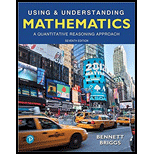
Concept explainers
Describe at least one way that mathematics is involved in each issue below.
Explanation of Solution
Given:
Example: The spread of AIDS: Mathematics is used to study the probability of contracting AIDS.
- The long term viability of the Social Security system
- The appropriate level for the federal gasoline tax
- National health care policy
- Job discrimination against women or ethnic minorities
- Effects of population growth (or decline) on your community
- Possible bias in standardized tests (e.g., the SAT)
- The degree of risk posed by carbon dioxide emissions
- Immigration policy of the United States
- Violence in public schools
- Whether certain types of guns or ammunition should be banned
- An issue of your choice from today’s news
- The long-term viability of the Social Security system:
- The appropriate level for the federal gasoline tax:
- National health care policy:
- Job discrimination against women or ethnic minorities:
- Effects of population growth (or decline) on your community:
- Possible bias in standardized tests (e.g., the SAT):
- The degree of risk posed by carbon dioxide emissions:
- Immigration policy of the United States:
- Violence in public schools:
- Whether certain types of guns or ammunition should be banned:
- An issue of your choice from today’s news:
Mathematics is used to study of statistics of how long the Social Security system is capable.
Mathematics is used to study excise tax on gasoline per gallon.
Mathematics is used to study statistics of what type of health care policy required in the state.
Mathematics is used to study workplace gender discrimination in the country.
Mathematics is used to study fertility, mortality, and migration trends to make projection about population growth and decline.
Mathematics is used to study probability of the undeserved students who are getting admission through standardized tests.
Mathematics is used to study the probability of death cases due to carbon dioxide emissions.
Mathematics involved in this case calculating the total transit of people across its borders into the country, and we can calculate the total people who intend to work and who stay in the country.
Mathematics is used to study the probability of the students involved in the criminal activity.
Mathematics involved calculating the killing cases by certain types of guns or ammunition.
The news states “US has foolishly given Pakistan more than 33 billion dollars in aid over the last 15 years, and they have given us nothing but lies & deceit.”
Mathematics is used to study the total amount went to Pakistan for CSF (Coalition Support Funds) Reimbursement, Security related and Economic Related.
Want to see more full solutions like this?
Chapter P Solutions
Using And Understanding Mathematics: A Quantitative Reasoning Approach Plus Mylab Math With Integrated Review And Student Activity Manual Worksheets (7th Edition)
- In preparing for the upcoming holiday season, Fresh Toy Company (FTC) designed a new doll called The Dougie that teaches children how to dance. The fixed cost to produce the doll is $100,000. The variable cost, which includes material, labor, and shipping costs, is $31 per doll. During the holiday selling season, FTC will sell the dolls for $39 each. If FTC overproduces the dolls, the excess dolls will be sold in January through a distributor who has agreed to pay FTC $10 per doll. Demand for new toys during the holiday selling season is extremely uncertain. Forecasts are for expected sales of 60,000 dolls with a standard deviation of 15,000. The normal probability distribution is assumed to be a good description of the demand. FTC has tentatively decided to produce 60,000 units (the same as average demand), but it wants to conduct an analysis regarding this production quantity before finalizing the decision. (a) Determine the equation for computing FTC's profit for given values of the…arrow_forwardFor all integers a and b, (a + b)^4 ≡ a^4 + b^4 (mod 4).arrow_forwardFor all integers a and b, (a + b)4 = a4 + b4 (mod 4). write a counterexamplesarrow_forward
- For all integers a and b, (a + b)^2 ≡ a^2 + b^2 (mod 2).arrow_forwardFor all integers a and b, (a + b)^3 ≡ a^3 + b^3 (mod 3).arrow_forwardFind a plane containing the point (3, -3, 1) and the line of intersection of the planes 2x + 3y - 3z = 14 and -3x - y + z = −21. The equation of the plane is:arrow_forward
- Determine whether the lines L₁ : F(t) = (−2, 3, −1)t + (0,2,-3) and L2 : ƒ(s) = (2, −3, 1)s + (−10, 17, -8) intersect. If they do, find the point of intersection. ● They intersect at the point They are skew lines They are parallel or equalarrow_forwardAnswer number 15arrow_forwardWhy researchers are interested in describing measures of the center and measures of variation of a data set?arrow_forward
 Discrete Mathematics and Its Applications ( 8th I...MathISBN:9781259676512Author:Kenneth H RosenPublisher:McGraw-Hill Education
Discrete Mathematics and Its Applications ( 8th I...MathISBN:9781259676512Author:Kenneth H RosenPublisher:McGraw-Hill Education Mathematics for Elementary Teachers with Activiti...MathISBN:9780134392790Author:Beckmann, SybillaPublisher:PEARSON
Mathematics for Elementary Teachers with Activiti...MathISBN:9780134392790Author:Beckmann, SybillaPublisher:PEARSON
 Thinking Mathematically (7th Edition)MathISBN:9780134683713Author:Robert F. BlitzerPublisher:PEARSON
Thinking Mathematically (7th Edition)MathISBN:9780134683713Author:Robert F. BlitzerPublisher:PEARSON Discrete Mathematics With ApplicationsMathISBN:9781337694193Author:EPP, Susanna S.Publisher:Cengage Learning,
Discrete Mathematics With ApplicationsMathISBN:9781337694193Author:EPP, Susanna S.Publisher:Cengage Learning, Pathways To Math Literacy (looseleaf)MathISBN:9781259985607Author:David Sobecki Professor, Brian A. MercerPublisher:McGraw-Hill Education
Pathways To Math Literacy (looseleaf)MathISBN:9781259985607Author:David Sobecki Professor, Brian A. MercerPublisher:McGraw-Hill Education





